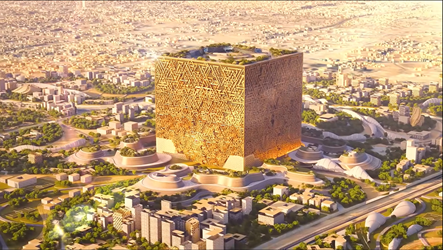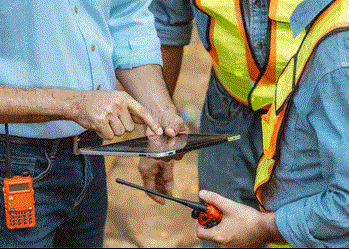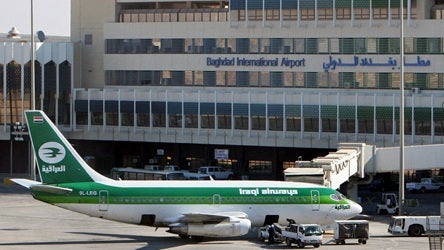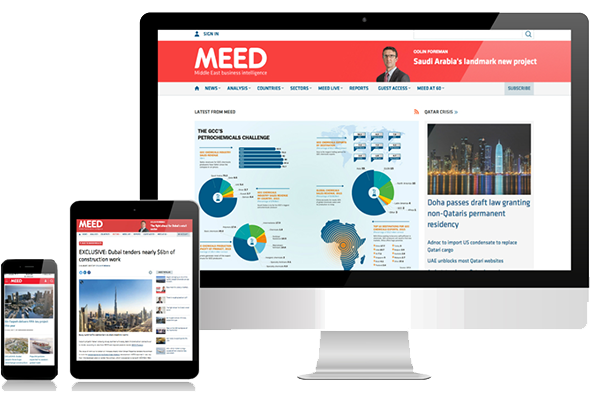Gaza conflict tests UAE-Israel ties
13 June 2024

The stance of the UAE towards Israel has cooled dramatically in the past eight months amid the conflict in Gaza, which is proving to be a major test of the partnership built between Abu Dhabi and Tel Aviv.
From boasting of warm and open trade dealings, the UAE has gone quiet on its business deals with Israeli partners, while on a political and diplomatic level the humanitarian tragedy in Gaza has increasingly drawn condemnatory statements from UAE officials.
It is a twist in developments that neither country could have foreseen, as nor indeed had Saudi Arabia, which was nearing its own normalisation agreement with Israel. It has also taken a bilateral strategic partnership that was long in the making into uncertain territory.
Long-term partnership
The 2020 Abraham Accords that normalised relations between the UAE and Israel came at the tail end of at least a decade’s worth of interaction between the two countries. The agreement emerged first and foremost as a set of shared strategic interests in opposition to regional threats in the early 2010s.
In a very tangible interaction in 2016, pilots from the UAE and Israel for the first time participated together in aerial combat training exercises hosted by the United States Air Force (USAF) in Nevada.
The UAE’s relationship with Israel also intersects with its relationship with the US, including its hope of securing access to advanced US military technology and assets, such as the F-35 Stealth Fighter Jet.
In September 2020, UAE foreign ministry spokesperson Hend Al-Otaiba stated that a request for the F-35 had been made six years previously, and that, “given that the UAE intends to be a partner to Israel, and already has a deep strategic partnership with the US, we are hopeful the request will be granted”.
While the sale of the F-35 by the US to the UAE has yet to materialise, relations between the UAE and Israel have nonetheless thrived on their own since the accords, on the basis of ongoing shared security interests and the opportunities for business, trade and investment between the two countries.
Since 2020, the value of trade between the UAE and Israel has swollen to about $3bn annually, and defence ties have only strengthened. In 2022, Israel supplied the UAE with air defence systems following long-range attacks on the UAE's oil infrastructure by the Iran-aligned Houthi movement in Yemen.
Israel-Palestine problems
It was as early as June 2023, however, that US Secretary of State Antony Blinken first warned that rising tensions in Palestine and Israel’s actions in the West Bank could imperil the process of normalisation.
With the advent of the war in Gaza, those fears of a damaging escalation in tensions have been realised.
As the conflict erupted in October, the UAE kept its distance and restricted itself to only the most limited commentary, condemning the “serious and grave escalation” by Hamas-led militants while calling for the full protection of all civilians under international humanitarian law.
By November, as the violence in Gaza ratcheted up, Abu Dhabi similarly affirmed its commitment to the accords even as individual UAE officials publicly condemned Israel’s actions and called for an end to the violence, pushing for a ceasefire, humanitarian aid and the release of hostages.
Anwar Gargash, a diplomatic adviser to the president, labelled the conflict a “profound setback” for the region, and stressed that the tragic course of events should lead to a political re-engagement on the issues of realising a two-state solution with East Jerusalem as its capital.
The close working relationship between the UAE and Israel nevertheless continued, as evidenced by Israel’s acquiescence to Abu Dhabi’s humanitarian efforts in Gaza, which have included the UAE setting up a field hospital and performing aerial aid drops in the territory.
The long grind of the conflict and the increasing inflexibility and intransigence on ceasefire negotiations by Israeli Prime Minister Benjamin Netanyahu have nevertheless steadily eroded this early good will.
While in early January, Gargash affirmed that the normalisation agreement was “a strategic decision, and strategic decisions are long-term”, by late January, senior UAE officials were ringing alarm bells.
Four months on, speaking at the Arab Media Forum in Dubai in late May, Gargash lambasted the conflict in Gaza as having taken on “brutal and inhuman dimensions”, stating that the “heinous attack in Gaza and Rafah cannot be overlooked” – a far more critical tone than his earlier conciliatory speech.
Unreliable partner
On the international stage, the disinclination of the Israeli government to listen to any of its key allies or partners has been trying for all, including the US. For Israel’s normalised partners in the Middle East, the conflict has underscored the tension between the Abraham Accords and underlying regional sentiments.
The UAE’s own founding father, Sheikh Zayed, was an ardent personal supporter of the Palestinian cause, and under his watch, the UAE was one of the first states to recognise Palestine as an independent state.
In the present, the humanitarian catastrophe in Gaza is drawing the competing influences of the UAE’s contemporary strategic interests and underlying sympathy for the Palestinian people into stark relief, and it is having a chilling effect on relations.
Public announcements in the UAE of deals with Israeli companies, which abounded before the conflict, have evaporated, and at least one very public deal has been put on hold amid the uncertainty.
Abu Dhabi National Oil Company (Adnoc) had been due to take a $2bn stake, alongside the UK’s BP, in Israeli gas producer NewMed, which holds 45% of Israel’s Leviathan offshore gas field.
In mid-May, Netanyahu suggested that the UAE could be involved in the governance of Gaza – drawing a swift rejection from UAE Foreign Minister Sheikh Abdullah Bin Zayed Al-Nahyan, who stated: “The UAE refuses to be drawn into any plan aimed at providing cover for the Israeli presence in the Gaza Strip.”
The episode was a stark demonstration of the breakdown in communication and diplomatic alignment between Abu Dhabi and Tel Aviv, and it joins a wider pattern of reports that UAE officials are already looking beyond Netanyahu and cultivating relations with his potential successors.
On 5 June, the UAE’s foreign minister again condemned the Israeli government after it allowed the divisive annual ‘Flag March’ of Israeli settlers through Jerusalem’s old city, as well as settler activism in the Al-Aqsa Mosque compound, despite the extraordinarily heightened tensions over Gaza.
For UAE-Israel ties to thrive, Abu Dhabi needs a government partner in Tel Aviv that it can work with on a productive basis to safeguard interests between the two countries while avoiding diplomatic affronts.
Unfortunately for the UAE, the current Israeli government – with the far-right ministers that Netanyahu has brought into the cabinet – has had a habit of proving itself to be the very antithesis of such a partner.
Looking ahead, it could be a long road for UAE-Israel ties to return to resembling their halcyon state of 2021-22, and it will take a government in Israel under someone other than Netanyahu to get there.
Exclusive from Meed
-
 WEBINAR: Mena Oil & Gas Projects Market 2025-26
WEBINAR: Mena Oil & Gas Projects Market 2025-2610 July 2025
-

-
 Chinese firm wins Mid Island Parkway tunnelling deal
Chinese firm wins Mid Island Parkway tunnelling deal10 July 2025
-
 Iraq tenders Baghdad airport PPP project
Iraq tenders Baghdad airport PPP project9 July 2025
-

All of this is only 1% of what MEED.com has to offer
Subscribe now and unlock all the 153,671 articles on MEED.com
- All the latest news, data, and market intelligence across MENA at your fingerprints
- First-hand updates and inside information on projects, clients and competitors that matter to you
- 20 years' archive of information, data, and news for you to access at your convenience
- Strategize to succeed and minimise risks with timely analysis of current and future market trends

Related Articles
-
 WEBINAR: Mena Oil & Gas Projects Market 2025-26
WEBINAR: Mena Oil & Gas Projects Market 2025-2610 July 2025
Date & Time: Tuesday 29 July 2025 | 11:00 AM GST
Agenda:
1. Summary of the Mena oil, gas and petrochemicals projects market
2. Summary description of the main megaprojects, including project programmes
3. Analysis of active contracts and spending to date
4. Analysis of top contracts by work already awarded
5. Long-term capital expenditure outlays and forecasts
6. Highlights of key contracts to be tendered and awarded over the next 18 months
7. Top contractors and clients
8. Breakdown of spending by segment, ie, oil, gas, petrochemicals – upstream, downstream, onshore and offshore
9. Q&A session
https://image.digitalinsightresearch.in/uploads/NewsArticle/14241705/main.gif -
 New Murabba signs up South Korean firm for design works
New Murabba signs up South Korean firm for design works10 July 2025
Register for MEED’s 14-day trial access
Saudi Arabia’s New Murabba Development Company (NMDC) has signed a memorandum of understanding (MoU) with South Korea’s Heerim Architects & Planners to explore further design works on assets at the 14 square-kilometre New Murabba downtown project.
According to an official statement: “Heerim Architects & Planners will explore distinctive architectural plans that complement the development’s masterplan, with special focus on anchor assets, linear parks and smart city features.”
New Murabba CEO Michael Dyke signed the agreement last week during the company’s Investment and Partnership Forum in Seoul.
At the event, NMDC also signed an MoU with South Korea’s Naver Cloud Corporation to explore technological solutions for delivering the New Murabba downtown project.
According to an official statement: “The three-year agreement covers exploring innovative technology and automation to support the delivery of New Murabba, including robotics, autonomous vehicles, a smart city platform and digital solutions for monitoring construction progress.”
NMDC is in Seoul to examine technological offerings, assess financing options and showcase the investment opportunities available for the New Murabba downtown development.
The statement added that the excavation works for The Mukaab, the centrepiece of the overall development, have now been completed.
The Mukaab is a Najdi-inspired landmark that will be one of the largest buildings in the world. It will be 400 metres high, 400 metres wide and 400 metres long. Internally, it will have a tower on top of a spiral base and a structure featuring 2 million square metres (sq m) of floor space designated for hospitality. It will feature commercial spaces, cultural and tourist attractions, residential and hotel units, and recreational facilities.
Downtown destination
The New Murabba destination will have a total floor area of more than 25 million sq m and feature more than 104,000 residential units, 9,000 hotel rooms and over 980,000 sq m of retail space.
The scheme will include 1.4 million sq m of office space, 620,000 sq m of leisure facilities and 1.8 million sq m of space dedicated to community facilities.
The project will be developed around the concept of sustainability and will include green spaces and walking and cycling paths to promote active lifestyles and community activities.
The living, working and entertainment facilities will be developed within a 15-minute walking radius. The area will use an internal transport system and will be about a 20-minute drive from the airport.
The downtown area will feature a museum, a technology and design university, an immersive, multipurpose theatre, and more than 80 entertainment and cultural venues.
 READ THE JULY 2025 MEED BUSINESS REVIEW – click here to view PDF
READ THE JULY 2025 MEED BUSINESS REVIEW – click here to view PDFUAE and Turkiye expand business links; Renewed hope lies on the horizon for trouble-beset Levant region; Gulf real estate momentum continues even as concerns emerge
Distributed to senior decision-makers in the region and around the world, the July 2025 edition of MEED Business Review includes:
> AGENDA: UAE-Turkiye trade gains momentum> INTERVIEW 1: Building on UAE-Turkiye trade> INTERVIEW 2: Turkiye's Kalyon goes global> INTERVIEW 3: Strengthening UAE-Turkiye financial links> INTERVIEW 4: Turkish Airlines plans further growth> CURRENT AFFAIRS: Middle East tensions could reduce gas investments> GCC REAL ESTATE: Gulf real estate faces a more nuanced reality> PROJECTS MARKET: GCC projects market collapses> INTERVIEW 5: Hassan Allam eyes role in Saudi Arabia’s transformation> INTERVIEW 6: Aseer region seeks new investments for Saudi Arabia> LEADERSHIP: Nuclear power makes a global comeback> LEVANT MARKET FOCUS: Levant states wrestle regional pressures> GULF PROJECTS INDEX: Gulf projects index continues climb> CONTRACT AWARDS: Mena contract award activity remains subdued> ECONOMIC DATA: Data drives regional projects> OPINION: A farcical tragedy that no one can endTo see previous issues of MEED Business Review, please click herehttps://image.digitalinsightresearch.in/uploads/NewsArticle/14239016/main.jpg -
 Chinese firm wins Mid Island Parkway tunnelling deal
Chinese firm wins Mid Island Parkway tunnelling deal10 July 2025

Register for MEED’s 14-day trial access
Beijing-headquartered China Railway Tunnel Engineering Group has won a $60m subcontract for the tunnelling works on package 1B of the Mid Island Parkway project in Abu Dhabi.
Package 1B entails the construction of a cut-and-cover tunnel to cross the Khor Laffan Channel, which is the area between the Saadiyat and Um-Yifeenah islands.
The tunnel, which will be between 900 metres and 1 kilometre (km) long, is being constructed on a design-and-build basis and will tie in to packages 1A and 1C.
The project is being jointly constructed by a joint venture of local firm Yas Projects (Alpha Dhabi Holding) and Beijing-based China Railway International Group.
In June last year, MEED exclusively reported that Abu Dhabi's Department of Municipality & Transport had awarded contracts for three packages for phase one of the Mid Island Parkway Project (MIPP), as part of the Plan Capital urban evolution programme.
Phase one will start at the existing Saadiyat Interchange, which will connect the E12 road to the MIPP, and will end with the recently constructed Um-Yifeenah Highway.
It comprises a dual main road with a total length of 8km, including four traffic lanes in each direction, two interchanges, a tunnel and associated infrastructure works.
MIPP phase one is further divided into packages 1A, 1B and 1C, which were awarded separately.
The project ownership has been transferred from Aldar Properties to Abu Dhaibi's Department of Municipalities & Transport.
Previously, it was transferred from Abu Dhabi General Services Company (Musanada) to Aldar Properties, and the project was included in the Abu Dhabi Investment Office's public-private partnership project pipeline.
 READ THE JULY 2025 MEED BUSINESS REVIEW – click here to view PDF
READ THE JULY 2025 MEED BUSINESS REVIEW – click here to view PDFUAE and Turkiye expand business links; Renewed hope lies on the horizon for trouble-beset Levant region; Gulf real estate momentum continues even as concerns emerge
Distributed to senior decision-makers in the region and around the world, the July 2025 edition of MEED Business Review includes:
> AGENDA: UAE-Turkiye trade gains momentum> INTERVIEW 1: Building on UAE-Turkiye trade> INTERVIEW 2: Turkiye's Kalyon goes global> INTERVIEW 3: Strengthening UAE-Turkiye financial links> INTERVIEW 4: Turkish Airlines plans further growth> CURRENT AFFAIRS: Middle East tensions could reduce gas investments> GCC REAL ESTATE: Gulf real estate faces a more nuanced reality> PROJECTS MARKET: GCC projects market collapses> INTERVIEW 5: Hassan Allam eyes role in Saudi Arabia’s transformation> INTERVIEW 6: Aseer region seeks new investments for Saudi Arabia> LEADERSHIP: Nuclear power makes a global comeback> LEVANT MARKET FOCUS: Levant states wrestle regional pressures> GULF PROJECTS INDEX: Gulf projects index continues climb> CONTRACT AWARDS: Mena contract award activity remains subdued> ECONOMIC DATA: Data drives regional projects> OPINION: A farcical tragedy that no one can endTo see previous issues of MEED Business Review, please click herehttps://image.digitalinsightresearch.in/uploads/NewsArticle/14238039/main3047.gif -
 Iraq tenders Baghdad airport PPP project
Iraq tenders Baghdad airport PPP project9 July 2025
Register for MEED’s 14-day trial access
Iraq’s Ministry of Transport and the General Company for Airport & Air Navigation Services have released a tender inviting firms to bid for a contract to develop Baghdad International airport on a public-private partnership (PPP) basis.
The notice was issued in July, and the submission deadline is in September.
According to an official statement posted on its website, Iraq’s Ministry of Transport said that 10 out of 14 international consortiums that expressed interest in the project earlier this year have been prequalified to compete for the tender.
The scope of the estimated $400m-$600m project involves rehabilitating, expanding, financing, operating and maintaining the airport. It is the first airport PPP project to be launched in Iraq.
The initial capacity of the airport is expected to be around 9 million passengers, which will be gradually increased to 15 million passengers.
The International Finance Corporation (IFC), a member of the World Bank Group, is the project’s lead transaction adviser.
Iraq is already developing the Baghdad and Najaf-Karbala metro projects using a similar PPP model.
Earlier this month, MEED reported that Iraq intends to retender the contract to develop and operate the Baghdad Metro project, following the award of the estimated $2.5bn contract last year.
According to local media reports, Nasser Al-Assadi, adviser to Prime Minister Mohammed Sudani, stated that the previous developers had overestimated the project budget; therefore, the government will relaunch the entire process to implement the project.
https://image.digitalinsightresearch.in/uploads/NewsArticle/14229008/main.jpg -
 Contractors prepare revised bids for Roshn stadium
Contractors prepare revised bids for Roshn stadium9 July 2025

Register for MEED’s 14-day trial access
Saudi gigaproject developer Roshn has invited firms to submit revised commercial proposals by 24 July for a contract to build a new stadium adjacent to the National Guard facilities to the southwest of Riyadh.
Known as the National Guard Stadium, it will be delivered on an early contractor involvement (ECI) basis. It will cover an area of over 450,000 square metres and be able to accommodate 46,000 spectators.
The scope of work also covers the construction of auxiliary facilities, including training academy offices and two hotels, as well as retail and food and beverage outlets.
The firms had initially submitted bids on 8 April for the contract.
The stadium is scheduled to host 32 Fifa World Cup tournament games in 2034.
In August last year, MEED reported that Saudi Arabia plans to build 11 new stadiums as part of its bid to host the 2034 Fifa World Cup.
Eight stadiums will be located in Riyadh, four in Jeddah and one each in Al-Khobar, Abha and Neom.
The proposal outlines an additional 10 cities that will host training bases. These are Al-Baha, Jazan, Taif, Medina, Al-Ula, Umluj, Tabuk, Hail, Al-Ahsa and Buraidah.
The bid proposes 134 training sites across the kingdom, including 61 existing facilities and 73 new training venues.
The kingdom was officially selected to host the 2034 Fifa World Cup through an online convention of Fifa member associations at the Fifa congress on 11 December 2024.
 https://image.digitalinsightresearch.in/uploads/NewsArticle/14228507/main.jpg
https://image.digitalinsightresearch.in/uploads/NewsArticle/14228507/main.jpg

